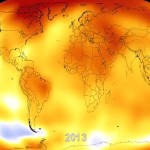
A 15-second NASA time-lapse video shows the steady and rapid warming of the planet since the middle of the twentieth century, with regions in the Arctic and Siberia warming as much as two to four degrees Celsius (3.6 to 7. 2 degrees Fahrenheit) above a long-term average:
The animation begins in 1950, but the intensity of the yellow, orange and red colors shows how much temperatures have increased compared to baseline temperature data collected from 1880 to the present.
NASA said that nine of the planet’s 10 warmest years have occurred since 2000, and worldwide surface temperatures continued to rise in 2013, according to satellite and meteorological data.
Since 1880, when atmospheric concentrations of carbon dioxide (CO2) were 285 parts per million (ppm), the average global temperature has risen 1.4 degrees Fahrenheit; atmospheric CO2 concentrations crossed a milestone of 400 ppm last year.
“Long-term trends in surface temperatures are unusual and 2013 adds to the evidence for ongoing climate change,” NASA climatologist Gavin Schmidt said.
Visit EcoWatch’s CLIMATE CHANGE page for more related news on this topic.


Leave a Reply
You must be logged in to post a comment.